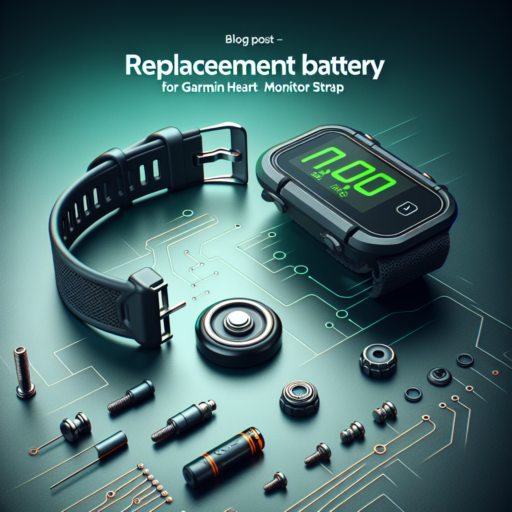How to replace Garmin heart rate strap battery?
Replacing the battery in your Garmin heart rate strap is a simple process that ensures your device continues to monitor your training sessions accurately. Start by locating the battery compartment on the back of the heart rate sensor. It’s essential to use the correct type of battery (often a CR2032) and to install it properly to avoid any disruptions in your device’s functionality.
Steps to Replace the Battery
- Turn Off the Device: Ensure your heart rate monitor is turned off before starting the replacement process to prevent any short circuits.
- Open the Compartment: Use a coin or a small screwdriver to twist open the battery compartment. This is usually located on the back of the sensor.
- Remove the Old Battery: Carefully take out the old battery, noting the orientation for when you install the new one.
- Install the New Battery: Place the new battery into the compartment, making sure the positive side is facing upwards.
- Seal the Compartment: Securely close the battery compartment to ensure water resistance and proper function.
After replacing the battery, it’s crucial to check that the heart rate monitor pairs successfully with your Garmin device. This can usually be done through the device’s settings under the sensors or accessories menu. If the heart rate strap is not pairing, double-check the battery orientation and the compartment closure to ensure everything is correctly in place.
Maintaining your Garmin heart rate strap with a fresh battery not only extends the life of your device but also ensures the accuracy of the heart rate data during your workouts. Regular checks and timely battery replacements will keep your training sessions on track and your heart rate data reliable.
What battery does a Garmin heart rate strap use?
Identifying the correct battery for your Garmin heart rate strap ensures continuous monitoring of your heart rate with precision. The Garmin heart rate strap typically relies on the CR2032 battery, a widely available coin cell battery. This battery is favored for its longevity and reliability, making it a perfect match for the energy-efficient design of Garmin’s heart rate sensors. Users appreciate the CR2032’s easy availability in stores and its straightforward replacement process.
When replacing the battery in your Garmin heart rate strap, it’s crucial to ensure that the new CR2032 battery is installed correctly. The positive side of the battery should face towards you, ensuring proper contact with the device’s terminals. This alignment is vital for re-establishing a seamless connection between your heart rate strap and your Garmin device. Additionally, users are recommended to check the battery compartment for any signs of corrosion or debris before inserting the new battery, as this could affect the device’s performance.
It’s also important to note that the lifespan of a CR2032 battery in a Garmin heart rate strap can vary based on usage patterns. Frequent use under varying environmental conditions can influence battery life, underscoring the importance of regular checks. Garmin advises users to be proactive in monitoring their device’s battery level to avoid unexpected disruptions during exercise or training sessions. By maintaining an awareness of battery status and having spare CR2032 batteries on hand, athletes can ensure that their Garmin heart rate strap remains a reliable companion for tracking fitness progress.
How long does Garmin chest strap battery last?
The lifespan of a Garmin chest strap battery is a common inquiry among fitness enthusiasts and athletes alike. Typically, Garmin chest strap batteries can last anywhere from 10 to 12 months, depending on usage and care. It’s important to note that this duration is based on average use, which Garmin often defines as approximately one hour per day, 7 days a week.
Several factors can influence the battery life of your Garmin chest strap. For example, exposure to extreme temperatures, either hot or cold, can shorten the battery life. Additionally, storing the chest strap when it’s wet, particularly after intense workouts or in humid conditions, can also affect battery longevity negatively. Keeping the strap clean and dry when not in use is imperative for extending battery life.
Maintaining Your Garmin Chest Strap for Optimal Battery Life
- Avoid exposing the device to extreme temperatures.
- Ensure the strap is completely dry before storing it.
- Remove the module from the strap when not in use, as this can help conserve battery power.
No se han encontrado productos.
How do I check the battery on my Garmin HRM strap?
Checking the battery on your Garmin Heart Rate Monitor (HRM) strap is essential for ensuring your fitness tracking remains accurate and reliable. Fortunately, the process is straightforward and can be done in a few simple steps. Begin by locating the battery compartment on the back of the module. It’s important to verify that your Garmin HRM strap is compatible with your Garmin device and that you’re using the correct type of battery recommended by the manufacturer.
Step-by-Step Guide to Checking the Battery
- First, carefully remove the module from the strap to prevent any damage.
- Use a small coin to twist open the battery compartment cover. Ensure not to apply too much force to avoid stripping the cover.
- Once open, check if the battery needs replacement by noting its current status. If it appears corroded or damaged, it’s time for a new battery.
- For a more thorough check, consider using a voltmeter or battery tester to assess the battery’s voltage and performance.
After assessing the battery’s condition, replacing it with a new one, if necessary, is crucial for maintaining the performance of your Garmin HRM strap. Make sure to follow the manufacturer’s instructions on replacing the battery to avoid any potential damage to the device. Remember, regular checks on your HRM strap’s battery will ensure that you can continually rely on your device for accurate heart rate data during your workouts.




